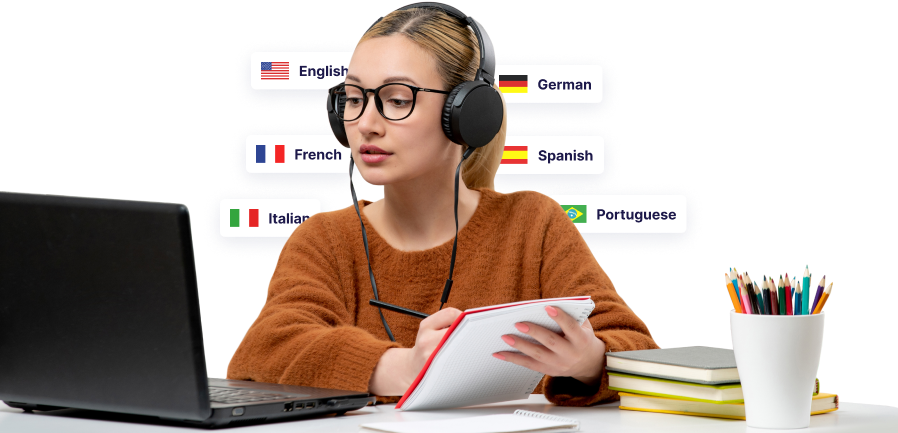Rapid Translate Team
Translation and localization may seem similar, but each process plays a unique role in a marketing strategy. Translation is just a small fraction of language solutions. Meanwhile, localization is the whole part with a more complex role.
Any business using two or more languages will need both solutions at some point.
Thus, you must know how to use both solutions for your marketing campaigns to yield positive results. This blog post will help you understand localization and translation, their key differences, and their uses.
Read on to get all the details for the perfect language solution!

Table of Contents
What Is Translation and Localization?
Localization and translation are effective language solutions for communicating with a target audience. Although used in place of each other, these two terms are different parts of language services. Understanding what translation and localization are should teach you about their differences.
Let’s take a look at their definitions.
What Is Translation?
Translation involves converting content from one language to another. This process involves understanding the context of the original message in the source language. Then, giving it the same meaning in a new language.
The purpose of translation is to provide information in a language the target audience understands. This process may cover direct translations of spoken, written, or sign language. In addition, you can complete a translation using a machine or human effort.
Machine translation involves a computer program changing text into different languages. It uses natural language processing to do this. Several machines can do this by themselves. There is also translation software to help human translators get faster results.
Machine translations are perfect for large amounts of text. However, their results may be less accurate than those of human translations. Human translation requires skill, expertise, and precision to deliver top-quality results. This method may take longer to complete the translation.
However, they create meaningful translations for the target audience. Translation considers the cultural differences between the source and target languages. In the end, it bridges the language barrier between various cultures, regions, and countries.
What Is Localization?
Localization is changing content to fit a target audience for a specific purpose. It changes the original content to the audience’s culture, rules, and local language. Although it may seem similar, translating content is a more basic process.
Content localization focuses on other aspects apart from converting texts. It also focuses on the meaning, cultural contexts, visual elements, emotion, and communication channels. It puts information in their native language. This helps the audience connect naturally.
The primary purpose of this process is to make products attractive to a target market. The change makes the content feel familiar to the target audience. It presents goods and services in a way that appeals to different cultures. This works by checking cultural preferences to change the presentation of business content.
It also considers the improved engagement of audiences in a foreign market. This will help to boost sales and reach. Localized content covers software and applications, websites, videos, games, and mobile apps to achieve this.
This ensures that a product or service is accessible to a target audience on various platforms.

What Is the Difference Between Translation and Localization?
The primary difference between translation and localization is the concern for the audience’s language and cultural differences. Other key differences make both processes unique.
We’ve highlighted three differences to help you make the best choice for your language solution.
1. Complexity
Localization is a broader and more complex language process. It involves various techniques to make your content suitable for a global audience. On the other hand, translation is a type of localization. It is just a tiny fraction of a bigger piece.
Translation is the starting point of every localized content. It converts the source language into the target language. However, localization techniques use these translations and other elements to make elements to make the audience like the content.
2. Objective
Translation focuses on keeping the content’s original meaning. It tries to maintain the text’s meaning, format, and layout in the target language. Meanwhile, the other process adapts the text to suit the target audience. It uses the location’s language and cultural contexts to change content.
A localization process considers the cultural references of the target location to appeal to the audience.
3. Technical Aspects
Localization involves more technical aspects than translation. It involves using relevant images, symbols, and other visual elements to appeal to the audience. It also involves the target market’s slogans, currency units, units of measurement, and date formats.
Apart from these, it considers the legal requirements of different markets. It involves the various laws regarding cookies, privacy policies, terms and conditions, etc. Any business hoping to expand its reach must adapt several technical and visual aspects.
Putting these elements in various cultures will enhance the user experience in the new market. However, translation is a key element to get all of this.

When You Need Translation and Localization Services
Localized and translated content is helpful for various purposes. Both services help send similar messages in different languages. However, using them takes a different approach.
Let’s take a look at when you need translation and localization services.
When You Need Localization
Suppose you want to introduce your product or service to a global market. In this case, this language solution is crucial for creating the perfect content for a specific region. This process would help you with content that reflects different languages and cultures. It is also useful to give users what they prefer.
You may even adapt the same content to fit different languages and cultures. You can localize the following:
- Websites: This involves texts and elements like currency units, color schemes, and imagery.
- Software and mobile applications: This process covers user interfaces, content, and instructions. It ensures they are perfect for the culture of audiences in different regions.
- Advertising materials: This includes social media posts, adverts, brand names and slogans, and other technical publications.
- Customer support services: This involves providing support in the customer’s native language. This can help improve user experience and satisfaction.
When You Need Translation
Translation is more suitable for developing text-based content like blog posts or websites. It maintains the source language’s original meaning and tone for the audience.
Translation services are helpful for various business activities. They enable companies to function and compete in a global market.
Here are some situations where you need translation services:
- Marketing materials translation like fliers, user manuals, and product descriptions.
- Legal document translation
- Human resource translation
- Financial document translations

FAQ
Why is localization important?
This process is essential for increased market reach and sales, enhanced brand reputation, and customer loyalty. By adjusting content to various cultures, brands can form a deeper bond with their target customers.
Localized content is also important for improving customer experience and engagement. Customers are more likely to accept products and content in their native language.
Should I use translation or content localization?
Depending on the purpose of your project, you can use either of the solutions. You should use translation to convert content to other languages.
You can also use localization to make content more culturally appropriate for a particular region.
What are some challenges in localization?
The common challenges of this process include cultural differences, language variations, and limited time and budget. Sometimes, the technical complexities of different languages may be difficult to convey in localized content.
In addition, different countries’ laws and regulations make adjusting content for local customers difficult. You may also have to deal with keeping the brand’s identity and similar tone in different cultural settings.
What are the best practices for localization?
Best practices for this process include planning early, choosing the right translators, and using appropriate tools. You should also test localized content thoroughly before using it on your target audience.
Furthermore, you should understand your target audience and their preferences to create suitable content.

Top 2 Translation and Localization Companies
Translation and content localization processes require skill and expertise. Using the best service providers is essential to avoid mistakes. Luckily, several translation and localization companies offer the best services.
We’ve identified two of them in this section.
1. BLEND
BLEND is a top AI-powered language solutions company providing effective communication for global businesses. Formerly known as One Hour Translation, the company aims to stop the language barrier between businesses and customers. BLEND provides its services to help businesses connect with their target market.
It completes projects based on a deep knowledge of local context, cultural references, and consumer behavior. In addition, it offers on-demand translation services for various purposes through BLEND Express.
BLEND uses translation management systems to get quick and accurate translations. It also has a network of over 25,000 expert linguists, editors, and voice actors to deliver the best quality.
In addition to this, you can get a personal account manager to help you throughout the process. BLEND provides services in over 120 languages and has many important clients.
2. Rapid Translate
Rapid Translate is a top translation company that provides outstanding services. Its services ensure the growth of your marketing strategy across various platforms. Rapid Translate’s network of professional linguists are native speakers of over 60 languages.
With their skill and expertise, we will ensure the best for your localization project. We follow your guidelines closely to get the same results throughout the process.
In addition to this, Rapid Translate offers high-quality translations for any purpose. Our services ensure similar quality standards for every translation project.
Our language solution process evaluates your content. We then adapt the result to the culture of the target audience.
Rapid Translate’s services are fast, affordable, and efficient. If you are looking for the perfect translation and localization solution, Rapid Translate is here for you.
Reach your target market and boost your reach with your ad copy, blogs, websites, and documents. Overcome language barriers and communicate with a larger audience through Rapid Translate’s services.
Order now to experience the strength of efficient language solutions!




